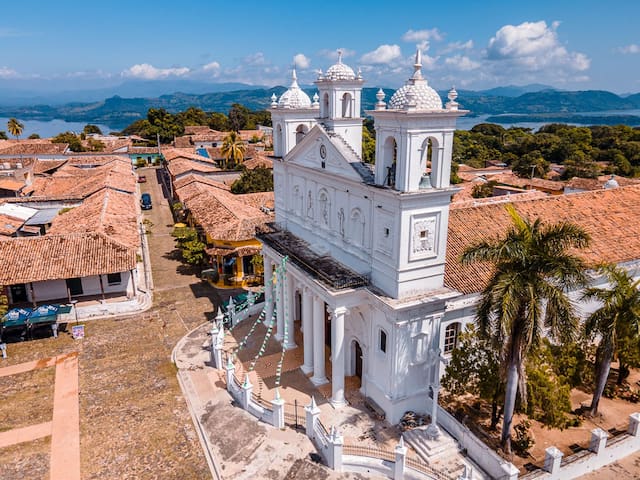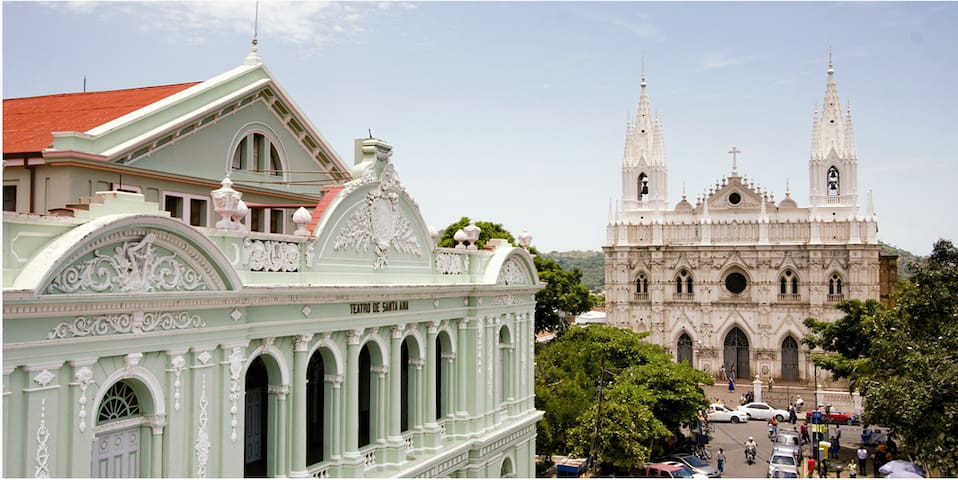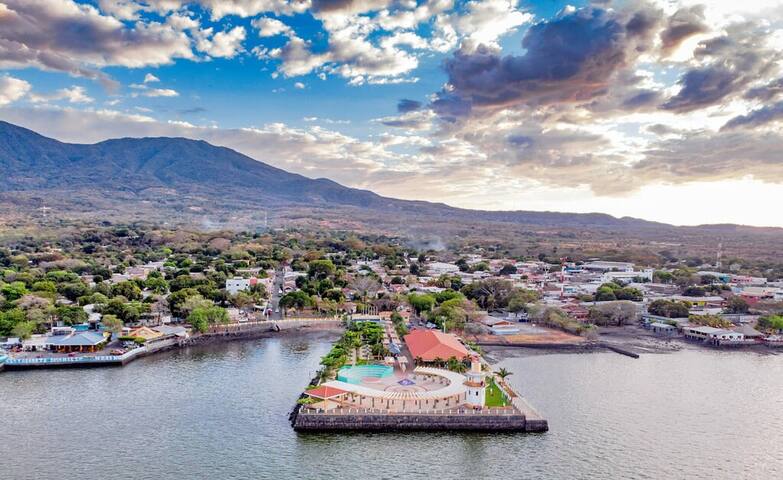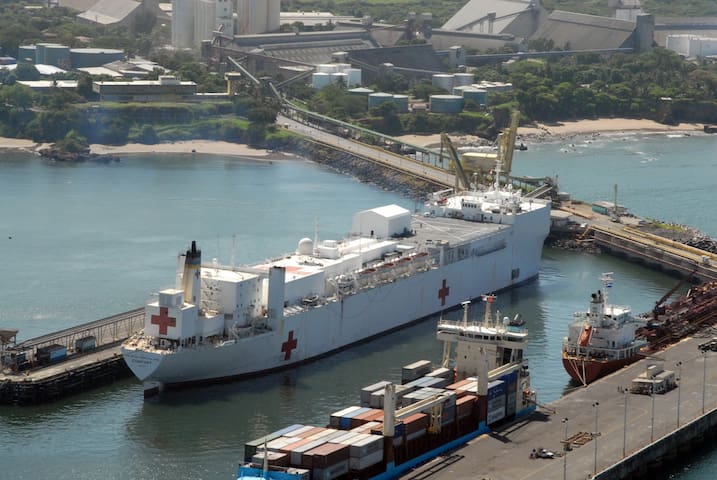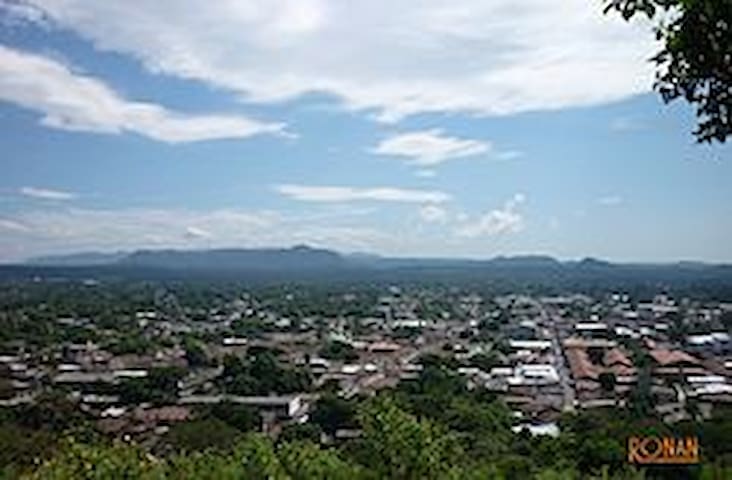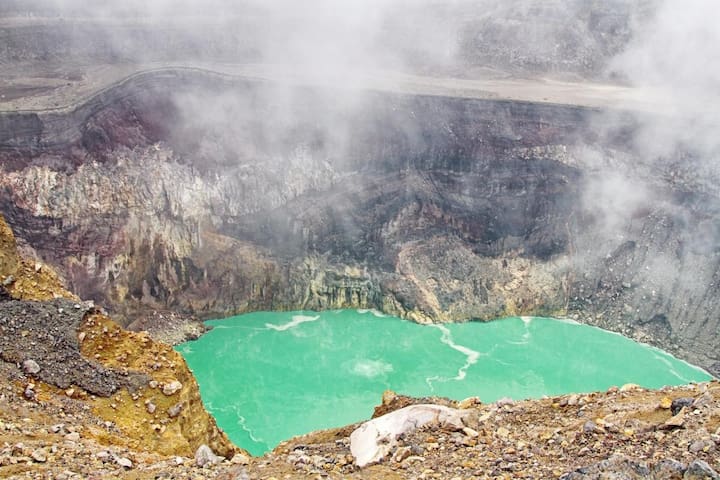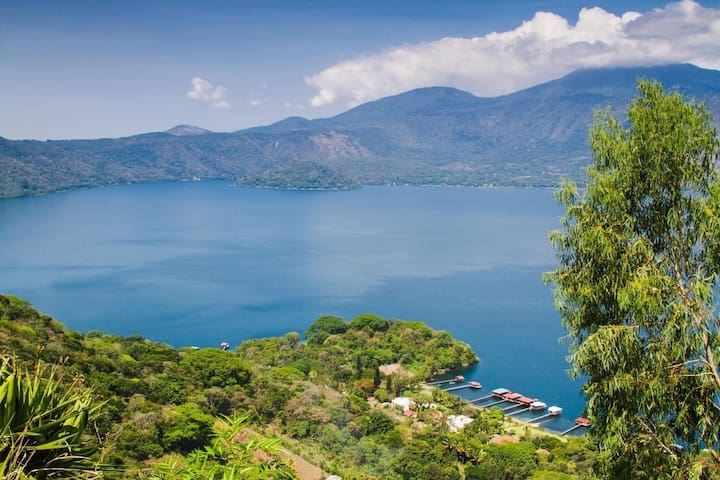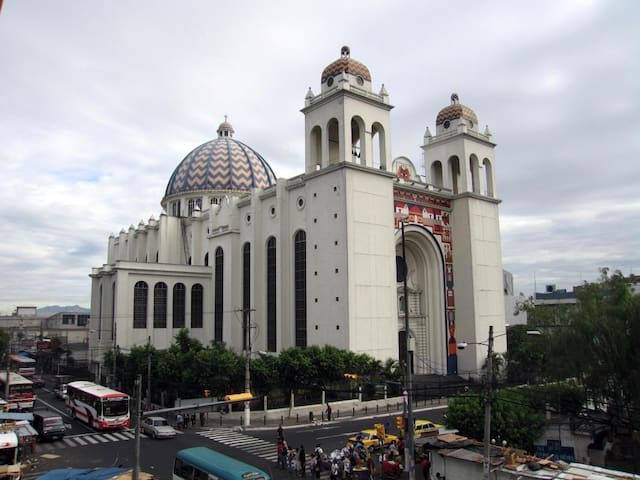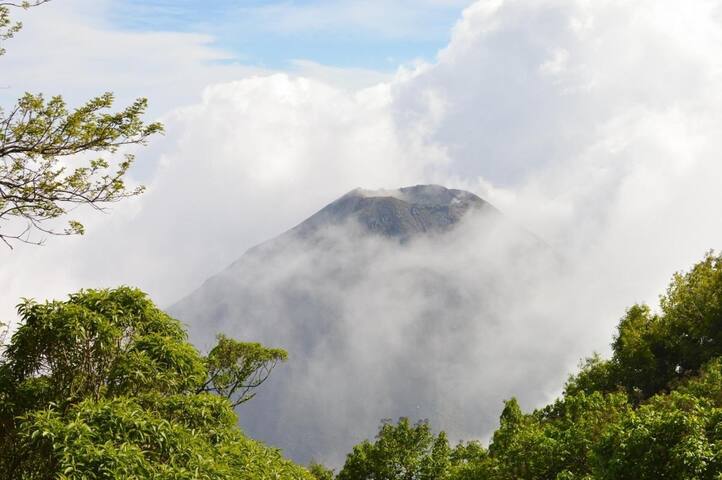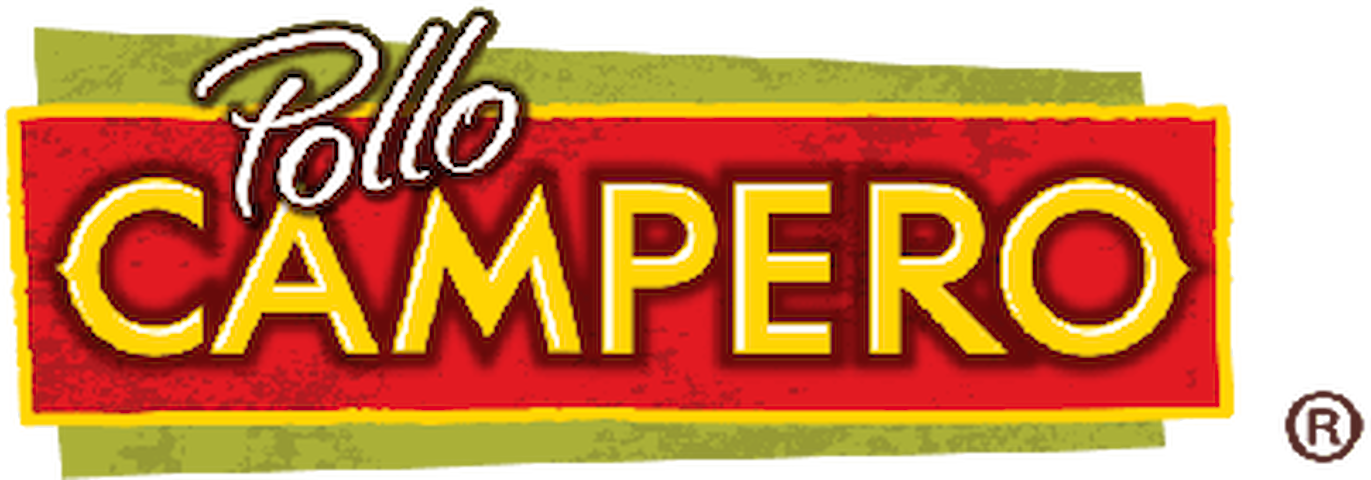City/town information
Two hours northwest of San Salvador, La Palma is famous for being the town where national artist Fernando Llort taught. Utilizing bright colors, childish images, and religious themes, Llort captured the hearts of the El Salvadoran people, making La Palma a nationally recognized artistic hub. Even today the vast majority of its residents make a living by practicing Llort’s artistic style.
9 locals recommend
La Palma
Two hours northwest of San Salvador, La Palma is famous for being the town where national artist Fernando Llort taught. Utilizing bright colors, childish images, and religious themes, Llort captured the hearts of the El Salvadoran people, making La Palma a nationally recognized artistic hub. Even today the vast majority of its residents make a living by practicing Llort’s artistic style.
Suchitoto is amongst the few towns in El Salvador that still retain its colonial architecture. Offering a laid-back ambiance, beautiful panoramic views, and quaint cobblestoned streets, this town is one of the country’s most charming. One of Suchitoto’s most popular sites is the Museo de los Recuerdos Alejandro Cotto (admission 4$). Here visitors can explore beautiful grounds, colonial architecture, great views, and classic fountains. Also boasting one of the country’s most impressive art collections, this museum (open daily) is like a town in and of itself!
32 locals recommend
Suchitoto
Suchitoto is amongst the few towns in El Salvador that still retain its colonial architecture. Offering a laid-back ambiance, beautiful panoramic views, and quaint cobblestoned streets, this town is one of the country’s most charming. One of Suchitoto’s most popular sites is the Museo de los Recuerdos Alejandro Cotto (admission 4$). Here visitors can explore beautiful grounds, colonial architecture, great views, and classic fountains. Also boasting one of the country’s most impressive art collections, this museum (open daily) is like a town in and of itself!
The second-largest city in El Salvador, Santa Ana offers visitors an urban appeal with a slightly more tranquil environment when compared to San Salvador. Its early 20th-century neo-Gothic cathedral, elaborately decorated theatre, and picturesque main square (Parque Libertad) have won the attention of tourists, making Santa Ana a (more than) worthwhile day trip.
13 locals recommend
Santa Ana
The second-largest city in El Salvador, Santa Ana offers visitors an urban appeal with a slightly more tranquil environment when compared to San Salvador. Its early 20th-century neo-Gothic cathedral, elaborately decorated theatre, and picturesque main square (Parque Libertad) have won the attention of tourists, making Santa Ana a (more than) worthwhile day trip.
The country’s third largest and most populated city, San Miguel is a popular, though slightly less developed, tourist destination. Its historical downtown offers some noteworthy landmarks, from the 19th century Cathedral and Francisco Gavidia Theatre to the San Miguel Market and bustling Avenida Roosevelt (great nightlife!)
San Miguel
The country’s third largest and most populated city, San Miguel is a popular, though slightly less developed, tourist destination. Its historical downtown offers some noteworthy landmarks, from the 19th century Cathedral and Francisco Gavidia Theatre to the San Miguel Market and bustling Avenida Roosevelt (great nightlife!)
La Unión is a municipality in La Unión Department of El Salvador. It is the capital city of the department of La Unión. It is the largest city in the department with a population of approximately 34,000 inhabitants. Previously known as Puerto San Carlos, was changed to La Unión on July 13, 1824. The name change followed after El Salvador got its independence from Spain and formed the United Provinces of Central America. La Unión became a department on June 22, 1865, and the city of La Unión was turned into a capital. On January 16, 2005 the Salvadoran government started building a port in La Unión,.
La Union
La Unión is a municipality in La Unión Department of El Salvador. It is the capital city of the department of La Unión. It is the largest city in the department with a population of approximately 34,000 inhabitants. Previously known as Puerto San Carlos, was changed to La Unión on July 13, 1824. The name change followed after El Salvador got its independence from Spain and formed the United Provinces of Central America. La Unión became a department on June 22, 1865, and the city of La Unión was turned into a capital. On January 16, 2005 the Salvadoran government started building a port in La Unión,.
Acajutla’s Port is located in the Pacific Ocean, at Sonsonate Department in El Salvador.
Is the in and out door of more than 95% of the bulk cargo and the containers of the country. Te main bulk products moved at this port are: grains, fuel, grease and oils, fertilizers, iron and steel products (importation); as sugar and molasses.
It is located about 86 kilometers of distance from San Salvador, about 85 minutes from San Salvador.
Around the port are the biggest warehouse plants which work as fiscal enclosures, both export and export. Also, the port has fiscal enclosures at the port facilities that allow store the cargo, both bulk and containers.
Acajutla
Acajutla’s Port is located in the Pacific Ocean, at Sonsonate Department in El Salvador.
Is the in and out door of more than 95% of the bulk cargo and the containers of the country. Te main bulk products moved at this port are: grains, fuel, grease and oils, fertilizers, iron and steel products (importation); as sugar and molasses.
It is located about 86 kilometers of distance from San Salvador, about 85 minutes from San Salvador.
Around the port are the biggest warehouse plants which work as fiscal enclosures, both export and export. Also, the port has fiscal enclosures at the port facilities that allow store the cargo, both bulk and containers.
The Department of Sonsonate, El Salvador was founded in June 12, 1824, his Department’s capital also has the same name, Sonsonate. According to the 2007 Census its population was 460,894 inhabitants. Sonsonate in Nahuatl language means “River of many waters” or “four hundred eyes of water”.
7 locals recommend
Sonsonate Department
The Department of Sonsonate, El Salvador was founded in June 12, 1824, his Department’s capital also has the same name, Sonsonate. According to the 2007 Census its population was 460,894 inhabitants. Sonsonate in Nahuatl language means “River of many waters” or “four hundred eyes of water”.
Historically, Metapán is known for iron ore production. The city had up to three furnaces for smelting. As of 1850, the city was producing 150 tons of iron a year.
Metapan
Historically, Metapán is known for iron ore production. The city had up to three furnaces for smelting. As of 1850, the city was producing 150 tons of iron a year.
Sightseeing
The San Salvador historic downtown includes the area where the capital city of El Salvador has been located since the 16th century. This district has long been the country's political, economic and religious center.
The history of San Salvador began here in the mid-16th century. After the pacification of the region by the Spanish conquistadors, the small town of Villa de San Salvador in the Valle de la Bermuda (Valley of Bermuda) was gradually abandoned. The settlement was relocated in 1545 to the valley known by the native Pipils as Zalcuatitán, and renamed "Valle de las Hamacas" by the Spaniards. This campsite was on the slope then called Palo Verde, and was known as "La Aldea". North of that site rose the Plaza Mayor, where the Plaza Libertad now stands. The Church dedicated to Santísimo Salvador del Mundo (the Holy Savior of the World) was erected on its east side
38 locals recommend
Centro Histórico de SS
The San Salvador historic downtown includes the area where the capital city of El Salvador has been located since the 16th century. This district has long been the country's political, economic and religious center.
The history of San Salvador began here in the mid-16th century. After the pacification of the region by the Spanish conquistadors, the small town of Villa de San Salvador in the Valle de la Bermuda (Valley of Bermuda) was gradually abandoned. The settlement was relocated in 1545 to the valley known by the native Pipils as Zalcuatitán, and renamed "Valle de las Hamacas" by the Spaniards. This campsite was on the slope then called Palo Verde, and was known as "La Aldea". North of that site rose the Plaza Mayor, where the Plaza Libertad now stands. The Church dedicated to Santísimo Salvador del Mundo (the Holy Savior of the World) was erected on its east side
The star attraction of the Cerro Verde National Park is also its most menacing – the Santa Ana Volcano (Volcán Ilamatepec), El Salvador’s biggest and most active volcano, last erupting as recently as 2005, when the force of the eruption flung car-sized rocks for more than 1.5 km.
Scaling the 2,381-meter peak of Santa Ana is a popular challenge for hikers, a 1.5-hour trail climbing up from the scenic San Blas Plateau and affording spectacular views of the neighboring Coatepeque caldera and Izalco volcano. From the summit, the views span the entire National Park, but equally impressive is the otherworldly terrain found at the top of the volcano and hikers can walk around the rim of the crater, looking out over the four nested calderas and an emerald green crater lake.
12 locals recommend
Volcan de Santa Ana
The star attraction of the Cerro Verde National Park is also its most menacing – the Santa Ana Volcano (Volcán Ilamatepec), El Salvador’s biggest and most active volcano, last erupting as recently as 2005, when the force of the eruption flung car-sized rocks for more than 1.5 km.
Scaling the 2,381-meter peak of Santa Ana is a popular challenge for hikers, a 1.5-hour trail climbing up from the scenic San Blas Plateau and affording spectacular views of the neighboring Coatepeque caldera and Izalco volcano. From the summit, the views span the entire National Park, but equally impressive is the otherworldly terrain found at the top of the volcano and hikers can walk around the rim of the crater, looking out over the four nested calderas and an emerald green crater lake.
A startling blue pool nestled beneath the peaks of the Cerro Verde, Izalco and Santa Ana volcanoes and fringed by sloping sugar and coffee plantations, Lake Coatepeque is among El Salvador’s most enchanting natural attractions, located on the cusp of the Cerro Verde National Park. At almost 6 km in length, this is the country’s largest lake, formed in the crater of an ancient volcano more than 50,000 years ago and nurturing a colorful population of catfish, guapote and zebra fish.
A tranquil holiday destination for both locals and travelers, the most popular activities at Lake Coatepeque are swimming and water sports, with sailing, kayaking, waterskiing and scuba diving all possible. Additional highlights include the hot springs dotted around the water’s edge and the island of Teopan, once an important place of Mayan worship.
79 locals recommend
Lago de Coatepeque
A startling blue pool nestled beneath the peaks of the Cerro Verde, Izalco and Santa Ana volcanoes and fringed by sloping sugar and coffee plantations, Lake Coatepeque is among El Salvador’s most enchanting natural attractions, located on the cusp of the Cerro Verde National Park. At almost 6 km in length, this is the country’s largest lake, formed in the crater of an ancient volcano more than 50,000 years ago and nurturing a colorful population of catfish, guapote and zebra fish.
A tranquil holiday destination for both locals and travelers, the most popular activities at Lake Coatepeque are swimming and water sports, with sailing, kayaking, waterskiing and scuba diving all possible. Additional highlights include the hot springs dotted around the water’s edge and the island of Teopan, once an important place of Mayan worship.
With its trio of volcanic peaks encircled by lush jungle, a vast network of hiking trails and the nearby crater lake of Coatepeque, the Cerro Verde National Park presents one of El Salvador’s most startlingly beautiful landscapes.
The main pastime for visitors to the Cerro Verde National Park is hiking and its three volcanoes, Izalco, Cerro Verde and Santa Ana, are all easily accessible. The highest point is the 2,381-meter summit of Santa Ana, El Salvador’s highest and most active volcano, capped with four craters and a glistening green crater lake, but equally dazzling are the views from neighboring Izalco, nicknamed the “Lighthouse of the Pacific” for its near-continuous eruptions over 160 years. Another highlight is climbing the eponymous peak and hikers scaling the now-extinct Cerro Verde volcano will find the mountaintop cloud forest filled with colorful birdlife, including hummingbirds, jays and emerald toucanets.
40 locals recommend
National Park Cerro Verde
1509 27 Avenida SurWith its trio of volcanic peaks encircled by lush jungle, a vast network of hiking trails and the nearby crater lake of Coatepeque, the Cerro Verde National Park presents one of El Salvador’s most startlingly beautiful landscapes.
The main pastime for visitors to the Cerro Verde National Park is hiking and its three volcanoes, Izalco, Cerro Verde and Santa Ana, are all easily accessible. The highest point is the 2,381-meter summit of Santa Ana, El Salvador’s highest and most active volcano, capped with four craters and a glistening green crater lake, but equally dazzling are the views from neighboring Izalco, nicknamed the “Lighthouse of the Pacific” for its near-continuous eruptions over 160 years. Another highlight is climbing the eponymous peak and hikers scaling the now-extinct Cerro Verde volcano will find the mountaintop cloud forest filled with colorful birdlife, including hummingbirds, jays and emerald toucanets.
With a trio of peaks set around the dramatic volcanic crater of El Boqueron, the wildflower covered slopes of El Boquerón National Park make a scenic hiking spot and at less than 30 minutes drive from San Salvador, it’s a popular choice for a day trip from the capital.
The main highlight of a visit to El Boquerón is the views, which look out over San Salvador and the distant Lake Ilopango and Izalco Volcano, and there are a number of lookout points to choose from. Walking trails run to the summits of El Boquerón, El Jabalí and El Picacho, the highest at 6,430 feet, and it’s also possible to hike down into the crater itself, a 1,600-foot deep caldera, measuring about 5 km in diameter.
55 locals recommend
San Salvador Volcano
With a trio of peaks set around the dramatic volcanic crater of El Boqueron, the wildflower covered slopes of El Boquerón National Park make a scenic hiking spot and at less than 30 minutes drive from San Salvador, it’s a popular choice for a day trip from the capital.
The main highlight of a visit to El Boquerón is the views, which look out over San Salvador and the distant Lake Ilopango and Izalco Volcano, and there are a number of lookout points to choose from. Walking trails run to the summits of El Boquerón, El Jabalí and El Picacho, the highest at 6,430 feet, and it’s also possible to hike down into the crater itself, a 1,600-foot deep caldera, measuring about 5 km in diameter.
Built between 1911 and 1917, San Salvador’s magnificent National Theatre of El Salvador (Teatro Nacional de San Salvador) is not only one of the city’s principal landmarks, but a National Monument and the oldest theater in Central America. Designed by French architect Daniel Beylard, the building is among the capital’s most notable works of architecture, with its stately Neo-classical façade giving way to lavish French Renaissance interiors, including a grand mural by Salvadoran painter Salvador Carlos Cañas.
Today, the 650-seat theater remains the heart of Salvadoran performing arts, hosting an ever-changing schedule of classical concerts, theater, folk music performances and art workshops.
16 locals recommend
National Theater
Calle DelgadoBuilt between 1911 and 1917, San Salvador’s magnificent National Theatre of El Salvador (Teatro Nacional de San Salvador) is not only one of the city’s principal landmarks, but a National Monument and the oldest theater in Central America. Designed by French architect Daniel Beylard, the building is among the capital’s most notable works of architecture, with its stately Neo-classical façade giving way to lavish French Renaissance interiors, including a grand mural by Salvadoran painter Salvador Carlos Cañas.
Today, the 650-seat theater remains the heart of Salvadoran performing arts, hosting an ever-changing schedule of classical concerts, theater, folk music performances and art workshops.
A pre-Columbian Mayan farming village dating back to A.D. 600 and El Salvador’s only UNESCO World Heritage site, the impressive ruins of Joya de Cerén were discovered in 1976 and have since become one of the country’s most visited archaeological sites.
Smothered by ash during an eruption of the Laguna Caldera volcano, the buried village was preserved in near-perfect condition, earning it the nickname of the ‘Pompeii of the Americas’ and offering a unique insight into the life and culture of the region’s ancient Mayan communities. Today, the remains of around 70 structures have been uncovered at the site, 10 of which have been excavated and are open to the public, including storehouses, kitchens, workshops, a worship area and a temezcal (ceremonial bath).
9 locals recommend
Joya de Ceren
A pre-Columbian Mayan farming village dating back to A.D. 600 and El Salvador’s only UNESCO World Heritage site, the impressive ruins of Joya de Cerén were discovered in 1976 and have since become one of the country’s most visited archaeological sites.
Smothered by ash during an eruption of the Laguna Caldera volcano, the buried village was preserved in near-perfect condition, earning it the nickname of the ‘Pompeii of the Americas’ and offering a unique insight into the life and culture of the region’s ancient Mayan communities. Today, the remains of around 70 structures have been uncovered at the site, 10 of which have been excavated and are open to the public, including storehouses, kitchens, workshops, a worship area and a temezcal (ceremonial bath).
The largest of El Salvador’s four national parks, El Imposible National Park is also home to one of the world’s most fragile ecosystems, offering refuge for a number of endangered animals and plant species. Set on one of the country’s most important historic trade routes, El Imposible (The Impossible) was named for its treacherously steep gorge that claimed the lives of many travellers and mules throughout the years.
Thankfully, since the building of a bridge across the pass back in 1968, exploring the park has been much easier and today the 3,800-hectare parklands are a prime spot for hikers - a sweeping landscape of riverside mangrove forests and rugged peaks soaring to heights of 1,450 meters. Wildlife spotting is another popular pastime with around 250 bird varieties found in the park, including rare species like Great Curassow, King Vulture, Turquoise-browed Motmot and black-crested eagles, as well as pumas, tigrillos, wild boars and a vast array of butterflies.
Parque Nacional El Imposible
The largest of El Salvador’s four national parks, El Imposible National Park is also home to one of the world’s most fragile ecosystems, offering refuge for a number of endangered animals and plant species. Set on one of the country’s most important historic trade routes, El Imposible (The Impossible) was named for its treacherously steep gorge that claimed the lives of many travellers and mules throughout the years.
Thankfully, since the building of a bridge across the pass back in 1968, exploring the park has been much easier and today the 3,800-hectare parklands are a prime spot for hikers - a sweeping landscape of riverside mangrove forests and rugged peaks soaring to heights of 1,450 meters. Wildlife spotting is another popular pastime with around 250 bird varieties found in the park, including rare species like Great Curassow, King Vulture, Turquoise-browed Motmot and black-crested eagles, as well as pumas, tigrillos, wild boars and a vast array of butterflies.
Between 600 and 900 AD, some 12,000 Mayans inhabited a city in the Valle de Zapotitán dominated by a step pyramid. The grass-covered ruins of the pyramid and a large courtyard were discovered in 1977, and excavation of the site continues to this day.
The archaeological evidence suggests that San Andrés was a trading city, as well as the provincial capital. Goods from as far as Honduras, Belize and Mexico passed through the settlement. Residents remained in San Andrés to as late as 1200, and in 1658, the abandoned city was covered in volcanic ash from El Playón, preserving many of the site’s original structures.
Today, the archeological park includes a museum showcasing artifacts from pre-Hispanic and Colonial eras.
15 locals recommend
San Andrés archeological site
CA 1WBetween 600 and 900 AD, some 12,000 Mayans inhabited a city in the Valle de Zapotitán dominated by a step pyramid. The grass-covered ruins of the pyramid and a large courtyard were discovered in 1977, and excavation of the site continues to this day.
The archaeological evidence suggests that San Andrés was a trading city, as well as the provincial capital. Goods from as far as Honduras, Belize and Mexico passed through the settlement. Residents remained in San Andrés to as late as 1200, and in 1658, the abandoned city was covered in volcanic ash from El Playón, preserving many of the site’s original structures.
Today, the archeological park includes a museum showcasing artifacts from pre-Hispanic and Colonial eras.
The national cathedral of El Salvador may not offer the same old-world architectural charms—like ornate stone work and detailed religious statues—of its European counterparts, but the iconic white Roman Catholic church is still a stunning monument and homage to San Salvador’s deeply religious roots.
Once the site of a violent massacre where some 40 people were killed during a stampede at the funeral of Archbishop Oscar Romero, today the iconic structure offers a bit of peace and tranquility for visitors to this capital city. The white façade gives way to a colorful interior, where images of the Divine Saviour and a four-column bladcchino bless the main altar. Travelers can spend a moment in quiet contemplation, light a candle, and take in the massive paintings that depict moments in the life of Christ while on a visit to the nation’s most famous cathedral.
17 locals recommend
Metropolitan Cathedral Of San Salvador
2a Calle OrienteThe national cathedral of El Salvador may not offer the same old-world architectural charms—like ornate stone work and detailed religious statues—of its European counterparts, but the iconic white Roman Catholic church is still a stunning monument and homage to San Salvador’s deeply religious roots.
Once the site of a violent massacre where some 40 people were killed during a stampede at the funeral of Archbishop Oscar Romero, today the iconic structure offers a bit of peace and tranquility for visitors to this capital city. The white façade gives way to a colorful interior, where images of the Divine Saviour and a four-column bladcchino bless the main altar. Travelers can spend a moment in quiet contemplation, light a candle, and take in the massive paintings that depict moments in the life of Christ while on a visit to the nation’s most famous cathedral.
Located within El Salvador’s Cerro Verde National Park (Parque Nacional Cerro Verde), the Izalco Volcano is the highest in the country and the park’s most visually beautiful peak. It’s also one of the most challenging treks in the park; it takes visitors an average of three hours (one way) to reach the summit at 6,404 feet (1,952 meters).
A baby when compared to other Central American volcanoes, Izalco only formed in 1770 and didn’t stop erupting until 1966. It’s violent eruptions made the volcano a natural beacon for sea farers off the Salvadoran coast, earning it the nickname Lighthouse of the Pacific. These same eruptions were also responsible for sculpting the volcano’s near perfect conical shape, lunar-like and unvegetated, with a 820-foot (250-meter) wide crater at its summit.
Izalco
Located within El Salvador’s Cerro Verde National Park (Parque Nacional Cerro Verde), the Izalco Volcano is the highest in the country and the park’s most visually beautiful peak. It’s also one of the most challenging treks in the park; it takes visitors an average of three hours (one way) to reach the summit at 6,404 feet (1,952 meters).
A baby when compared to other Central American volcanoes, Izalco only formed in 1770 and didn’t stop erupting until 1966. It’s violent eruptions made the volcano a natural beacon for sea farers off the Salvadoran coast, earning it the nickname Lighthouse of the Pacific. These same eruptions were also responsible for sculpting the volcano’s near perfect conical shape, lunar-like and unvegetated, with a 820-foot (250-meter) wide crater at its summit.
Cascada Los Tercios-Suchitoto El Salvador
Carretera a CinqueraFood scene
Fantastic atmosphere! Very modern brewery with a open concept sitting! The logo, the bar taps, the illustrations on the wall are extremely well designed. I love the name of their brews, they're very clever. I would love to see this bar outside of El Salvador.
7 locals recommend
Cadejo Brewing Company
Fantastic atmosphere! Very modern brewery with a open concept sitting! The logo, the bar taps, the illustrations on the wall are extremely well designed. I love the name of their brews, they're very clever. I would love to see this bar outside of El Salvador.
Best Mexican place in El Salvador all the sauces are really good i always have them all as I wish, they’re not so spicy..tried the Tacos al pastor and sopes at this location
Laca Laca - La Skina
Best Mexican place in El Salvador all the sauces are really good i always have them all as I wish, they’re not so spicy..tried the Tacos al pastor and sopes at this location
It’s fast food.... but their service is amazing and the prices are right. you can have lunch or breakfast, but the chicken is really where it’s at.
Pollo Campero Condado Santa Rosa
Calle RealIt’s fast food.... but their service is amazing and the prices are right. you can have lunch or breakfast, but the chicken is really where it’s at.
Traveler advice
Getting around
By Car
El Salvador is one of the easiest countries in Central America to see by car, since it boasts newly constructed, well-paved, and well-marked highways running the length of the country from east to west and north to south. Hwy. CA-1, also known as the Pan-American Highway or "Carretera Panamericana," is the nation's main artery traveling from the western Guatemalan border through San Salvador to the eastern Honduran border. Hwy. CA-2 runs the same direction along the coast and is intersected by three major north-south highways running the length of the country. Once you get off the main roads,
What to pack
Make sure to pack your summer essentials :-)
The following suggestions are put together for anyone traveling to El Salvador, whether it be to visit friends or relatives, for business or just for a visit of the country.
How to Pack: El Salvador is hot and humid any time of the year. Rainy season begins usually at the beginning of May and runs through October, so plan accordingly. Bring light weight clothing, but appropriate clothing. In many rural areas it is still inappropriate for women to wear pants and especially shorts so be sure to pack some skirts, sisters, just in case! You’ll see few bikinis on El Salvador’s public beaches as in
Useful phrases
SALVADORAN SLANG
¿QUÉ ONDAS?
¡CHIVO!
¡PÚCHICA!
¡CABAL!
¡NO TENGO PISTO!
¡ES DE CHOTO!
¡VAYA PUES!
¡QUE LE VAYA BIEN!
¡TE PELASTE!
¿...Y VOS?


